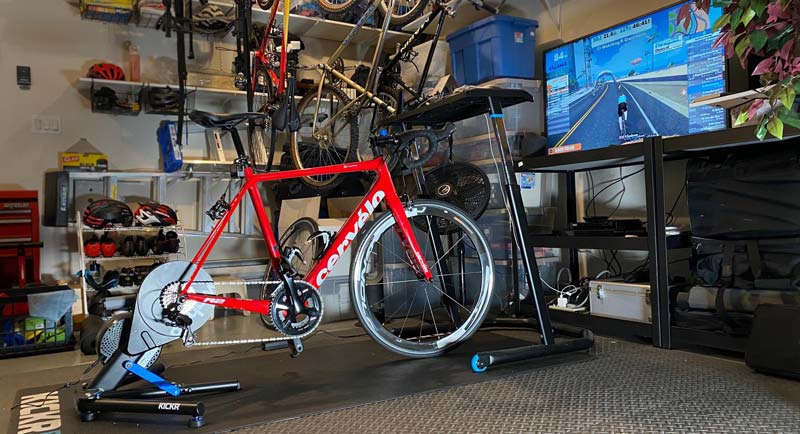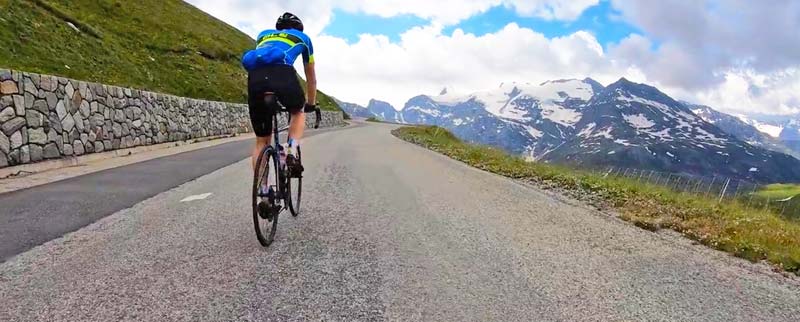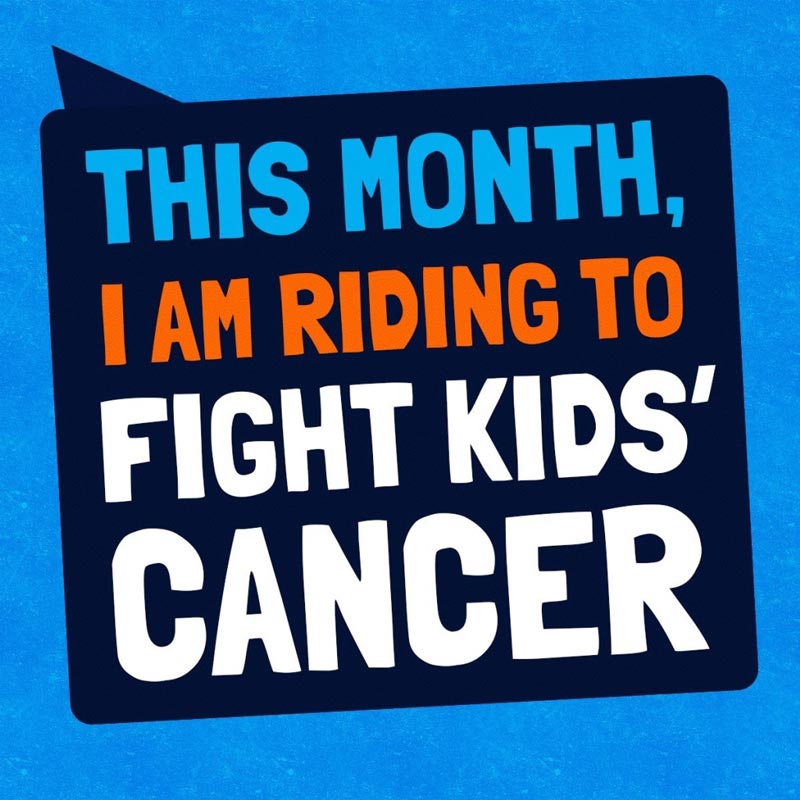What goes through your mind when you get up in the morning? That workout you’re heading out for? Your projects at work? If you’re a dancer, maybe your next lesson, practice, or competition? For kids with cancer, the big goal ahead of them each day might be just to get out of bed.
Update September 9: My month of riding has completed, but you can still donate! This is an amazing cause and the donation page will be open until the end of September. Final results:
Funds raised: $3,019
Total distance: 1,307km
Time on bike: 49 hours 24 minutes
Elevation gain: 10,234 meters (1 km higher than Mount Everest!)
During the month of August, I’m cycling 1,200km as part of the Great Cycle Challenge to raise funds for the SickKids Foundation and Toronto’s SickKids Hospital. This hospital has a long history of helping kids with cancer. The Challenge is a fund-raising effort that lets you ride your bicycle as much as you like during a single month. Usually the ride takes place in June, but because of the COVID-19 pandemic, this year’s effort was moved to August. This will be my third year supporting the event. Last year we had our dance cruise followed by our focus on organizing Delta Cup, so I couldn’t take part.
A charity worth supporting
The Hospital for Sick Children, now known as SickKids Hospital, opened its doors way back in 1875 and has been fighting a battle to give hope to children and their families ever since. In 1908, the forward-thinking Hospital staff insisted that a milk pasteurization plant be installed onsite, to prevent the spread of disease through contaminated milk, 30 years before pasteurization became mandatory across the nation. In 1920 the Hospital pioneered blood transfusions for children. Pablum, the low-cost, quick-to-prepare, nutrient-enriched cereal was introduced here in 1930, another of Canada’s gifts to the world. In 1976 this Hospital pioneered bone marrow transplants. In 2009, they introduced the world’s first cardiac surgery in utero, saving kids who have not been born. And this pioneering spirit continues. Just a few years ago SickKids Hospital performed North America’s first incisionless bone tumour surgery, removing cancerous tumours in bone without aid of a scalpel.
SickKids Hospital performed North America’s first incisionless bone tumour surgery, removing cancerous tumours in bone without aid of a scalpel.
Giving hope to kids
Cancer is the largest killer of children from disease in Canada. Over 1,400 Canadian children are diagnosed with cancer every year. These kids have the potential to be business owners, leaders, teachers, trades people, artists and dancers, yet they are struggling just to get through the next days, weeks or months because of their disease. I’m riding to help give them hope.
I’m always amazed at how brave kids are when faced with severe diseases like cancer. They deserve a bright future, full of potential and wonder. When my legs starts to hurt after 60km or so, I think of how much it must hurt any one of those kids to get needles jammed into their arms every day. When I feel exhausted, I think of how they must feel after chemotherapy.
Chances are you’ve lost someone close to you through this disease, as have I. I can’t even imagine what it’s like to try and keep your positive energy up when going through those treatments. It’s important that we do something to help eradicate cancer, whether it’s raising funds, giving funds, or helping those going through the disease. I’m pushing myself physically to help give hope to kids struggling through cancer. Who knows how many of these brave kids might help change the world once they are free of the disease?
To achieve my goal, I have to ride an average of 38km each and every day throughout the month. The weather won’t always cooperate here in Vancouver so when it rains I’ll mount my road bike on my stationery trainer to put in the miles. Because of my busy work schedule, some days won’t allow a bike ride to happen at all so that adds additional length to the next ride in order to meet my goal.
Special Challenge: The World’s Most Iconic Climbs
 As a special opportunity to make your involvement more fun and more challenging for me, I’m giving you the chance to select one of the world’s most famous climbs for me to ride. Just select one from the list below, make the appropriate donation and let me know. I’ll ride it to thank you for your gift. Look over the list below to make your choice.
As a special opportunity to make your involvement more fun and more challenging for me, I’m giving you the chance to select one of the world’s most famous climbs for me to ride. Just select one from the list below, make the appropriate donation and let me know. I’ll ride it to thank you for your gift. Look over the list below to make your choice.
How is it possible to ride mountains far from home? Modern technology allows me to ride pretty much anywhere in the world. Software programs like FulGaz and Zwift use real GPS data to assign distance and elevation to rides on a computer, using video aids to make it just like the real thing. The software links to my smart trainer, a Wahoo KICKR, to automatically change the tension on the back wheel. As a result, every change in elevation feels exactly the way it does if I were to ride the road in the normal geographic setting. Steep mountain climbs are truly relenting. Sometimes you are standing on the pedals for half an hour at a time just to relieve the legs.

Col du Galibier from Col du Lautaret
Rhones-Alpes, France
This route contains a monument of Henry Desgrange, founder of the Tour de France.
Elevation Gain: 556 meters (1,824 feet)
Estimated Time: 1 hour
Minimum Donation: $100
This climb has been sponsored by Judith McLeod. Thank you Judith, for supporting the fight against kids’ cancer with your generous donation!

Alpe d’Huez
Auvergne-Rhône-Alpes, France
An iconic Tour de France ride, used most years. The climb features 21 switchbacks, with an average gradient of about 8%.
Elevation Gain: 1,065 meters (3,494 feet)
Estimated Time: 1 hour 30 minutes
Minimum Donation: $100
This climb has been sponsored by Chris Dinnell. Thank you Chris, for supporting the fight against kids’ cancer with your generous donation!

Col d’Aspin from Arreau
France
There are different ways to attack the Col d’Aspin. The climb from Arreau is the more challenging side.
Elevation Gain: 767 meters (2,516 feet)
Estimated Time: 1 hour 15 minutes
Minimum Donation: $100
This climb has been sponsored by Roger and Sherry Everett, and a second ride up the Aspin has been sponsored by Richard Nash. Thank you for supporting the fight against kids’ cancer with your generous donation!

Col de Peyresourde (east)
Loudervielle, France
Classic climb featured more than 50 times in the Tour de France.
Elevation Gain: 896 meters (2,939 feet)
Estimated Time: 1 hour 15 minutes
Minimum Donation: $100
This climb has been sponsored by Peter and Jill Thesiger. Thank you for supporting the fight against kids’ cancer with your generous donation!

Col de la Madone
Menton, Alpes-Maritimes, France
Such an iconic climb that Trek named their flagship road bike after it.
Elevation Gain: 993 meters (3,257 feet)
Estimated Time: 1 hour 30 minutes
Minimum Donation: $100
This climb has been sponsored by Dave and Jenny Stumpo. Thank you for supporting the fight against kids’ cancer with your generous donation!

Col du Telegraphe to Valloire
Saint-Michel-de-Maurienne, France
Often used as the opening act before the mighty Col du Galibier, this route was last used in the Tour de France in 2017. Many sections feature a 10% gradient.
Elevation Gain: 831 meters (2,726 feet)
Estimated Time: 1 hour 15 minutes
Minimum Donation: $100
This climb has been sponsored by Garth McFadden. Thank you Garth, for supporting the fight against kids’ cancer with your generous donation!

Col d’Aubisque
Pyrénées-Atlantiques, France
A legend of the Tour de France.
Elevation Gain: 950 meters (3,117 feet)
Estimated Time: 2 hours
Minimum Donation: $150

Col d’Iseran
Savoie, France
This ride climbs to the highest paved pass in the French Alps. Last used on stage 9 in the 2007 Tour de France.
Elevation Gain: 974 meters (3,195 feet)
Estimated Time: 2 hours
Minimum Donation: $150

Mont Ventoux
Provence, France
An essential climb for fans of the Tour de France. Steep and relentless. Often referred to as the ugliest mountain climb in the Tour because of the barren, rocky terrain.
Elevation Gain: 1,581 meters (5,187 feet)
Estimated Time: 2 hours 15 minutes
Minimum Donation: $150

Col de la Madeleine from La Chambre
Auvergne-Rhône-Alpes, Savoie, France
One of the most famous climbs in the history of the Tour de France, used 25 times since 1969.
Elevation Gain: 1,533 meters (5,029 feet)
Estimated Time: 3 hours
Minimum Donation: $200

Col du Tourmalet
Luz-Saint-Sauveur, Pyrenees, France
One of the most iconic climbs in all of cycling, and the most brutal effort in this series, first introduced to the Tour de France in 1910. Starting off in a picturesque town, the ride gets increasingly steep as it gets higher. It may not be as high as the Madeleine, but it is harder!
Elevation Gain: 1,350 meters (4,429 feet)
Estimated Time: 3 hours
Minimum Donation: $250
Cycling for dancers
 Cycling can be scary for a dancer, but it’s also a good form of exercise for those involved in dance. Cycling strengthens the quads and glutes, as well as hamstrings and calves, all good muscles for dancers to work on. Best of all, it builds stamina, an essential component for ballroom dancing.
Cycling can be scary for a dancer, but it’s also a good form of exercise for those involved in dance. Cycling strengthens the quads and glutes, as well as hamstrings and calves, all good muscles for dancers to work on. Best of all, it builds stamina, an essential component for ballroom dancing.
It’s scary because of the potential for injury. Of course, one might say that about any sport, but I’ve had my share of accidents and close calls. Just six weeks before my very first dance competition, a drunk driver failed to navigate a bend I was riding through. Even though I was well into the bike lane shoulder area, he hit me, fracturing my pelvis. I was still able to dance the event a month and a half later, but it demonstrated how fragile we are on a bike. I’ve seen people run red lights right in front of me, had drivers try to force me off the road, had car doors open in front of me, and dealt with idiots who don’t know how to share the road, or they just don’t care. Cyclists need to have their situational awareness tuned to 150% every moment they’re riding to stay safe.
There’s also the physical challenge. As we get older, we realize we can’t do what the body used to be able to do. Average speeds aren’t what they were years ago. So I’m becoming aware that there’s a huge value in doing this kind of additional cross training to keep the body in shape.
Riding every day is hard. I don’t know how pro riders do it. After two hours you notice just how much your legs and body hurt. You wonder if you’ll be able to push through the next sprint in anywhere close to your personal best speed. Headwinds are tedious and crosswinds dangerous. Hands and butt can get pretty sore after a couple of hours on the bike. Riding when you’re still sore from the day before multiplies the difficulty. But when I start feeling those things I think of the kids with cancer and what they go through every day and it helps put things in perspective.
Please help support my effort. You can donate online here














